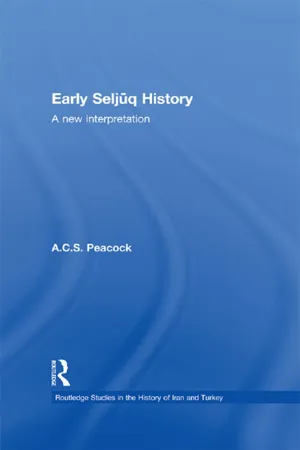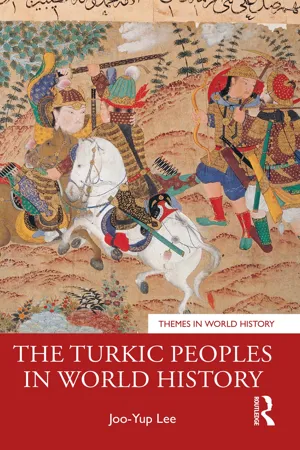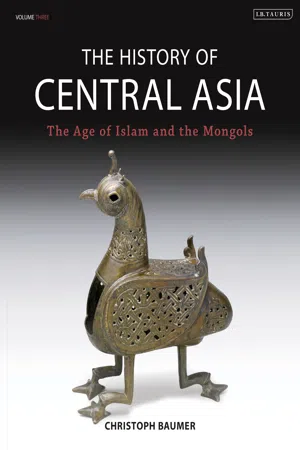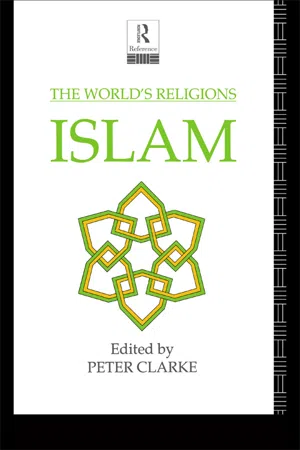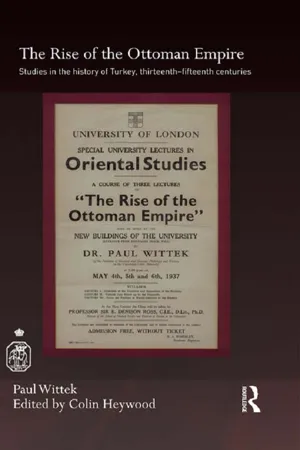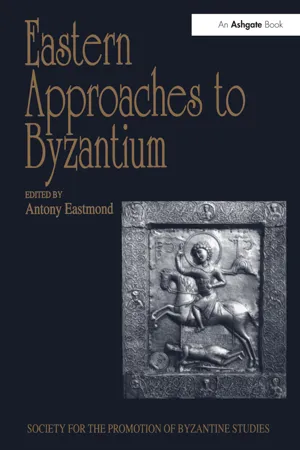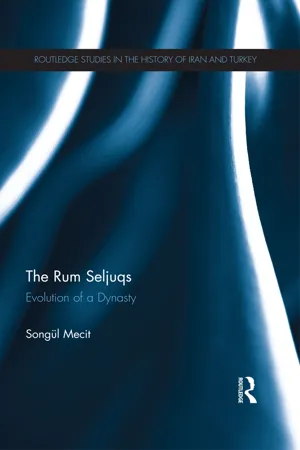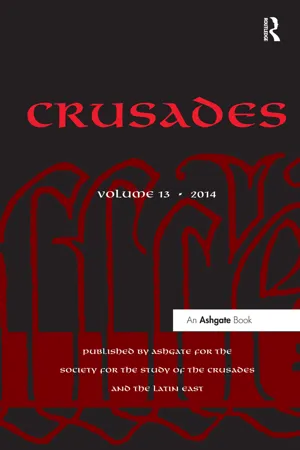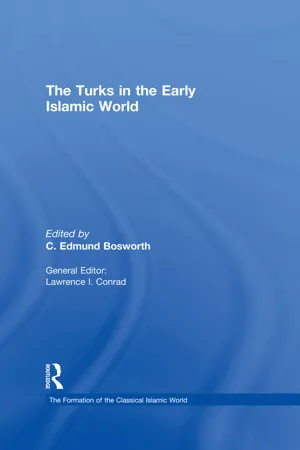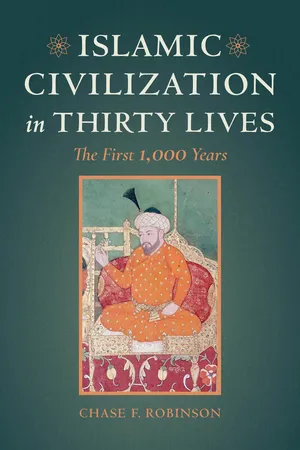History
Seljuk Turks
The Seljuk Turks were a medieval Turkic empire that emerged in the 11th century, known for their expansion across the Middle East and Asia Minor. They played a significant role in the spread of Islam and the subsequent interactions between the Islamic world and the Christian Byzantine Empire. The Seljuks also made important contributions to art, architecture, and literature during their rule.
Written by Perlego with AI-assistance
Related key terms
12 Key excerpts on "Seljuk Turks"
- eBook - ePub
Early Seljuq History
A New Interpretation
- A.C.S. Peacock(Author)
- 2013(Publication Date)
- Routledge(Publisher)
Introduction The early Seljūqs in mediaeval and modern historiography The subject of this book is the rise of a group of Turks from their origins as an obscure tribe living in the west Eurasian steppes to rulers of an empire that dominated the Middle East and Central Asia. Led by the descendants of the chief Seljūq b. Duqāq, in the first half of the eleventh century the Turks captured the established centres of civilisation of the Islamic world – the great cities of Transoxiana, Iran and Iraq – and reached far into Anatolia and the Caucasus. The Ghaznavid, Būyid and Byzantine Empires that dominated Central Asia, Iran and Iraq, and Anatolia all met defeat at the hands of the armies of Turkish nomads. 1 This book examines how this sudden transformation from tribe to empire came about, concentrating on the little-known but formative period up to the death of the second sultan, Alp Arslān, in 465/1072. The period of Seljūq rule, the eleventh and twelfth centuries, marks a turning point in demography, religion and administration in the Middle East. The demography of the region changed permanently, for the invasions of the Seljūqs were accompanied by – indeed were part of – significant migrations. Ultimately these led to the formation of Turkish populations in Anatolia, Azerbaijan and the Caucasus that exist there today. The Seljūq period also marks the reassertion of Sunni domination in the Middle East, which had been eclipsed by the rise of the Shi’ite Būyid dynasty in Iran and Iraq and the Ismā’īlī Fāṭimid Empire in Syria, Egypt and North Africa in the tenth century. It was under Seljūq rule that scholars like al-Ghazālī reconciled Sufism with orthodox Islam, and it was then that the madrasa or religious school came to prominence. Both developments were to shape the subsequent religious and intellectual history of the Middle East - eBook - ePub
- Sir Percy Sykes(Author)
- 2013(Publication Date)
- Routledge(Publisher)
OGHRIL BEG .CHAPTER LII THE COMING OF THE Seljuk TurksWhile Apulia and Sicily were subdued by the Norman lance, a swarm of northern shepherds overspread the kingdoms of Persia; their princes of the race of Seljuk erected a splendid and solid empire from Samarcand to the confines of Greece and Egypt.—GIBBON .The Importance of the Seljuks.—The previous chapter is little more than a medley, dealing as it does with numerous short-lived dynasties which seized upon various provinces of the decrepit Caliphate and then tumbled to pieces mainly from internal dissensions. The advent of a new power, the Seljuk Turks, constitutes a notable epoch in the history of the Middle and Near East, if only because it swept away these insignificant and divided dynasties and once again united Islam under a single powerful sway, stretching from Turkestan to the Mediterranean Sea. More than this, the Seljuks, with the fervour of recent converts, revitalized Islam, just as the Norsemen revitalized Christendom, and when Europe under Norman leaders attacked the East under the impulse of the Crusades it was the light horse of the Seljuks which met the heavy horse of the Crusaders.1Their Origin.—The Seljuks were a branch of the Ghuzz Turks, from whom, however, they kept distinct. Their founder was Tukák (signifying a bow), the father of Seljuk, who with his tribe crossed from Turkestan into Transoxiana and embraced Islam with deep fervour. He and his descendants took part in the wars of the period, and speedily came into collision with Mahmud. The story runs that the great Conqueror asked Israil, the son of Seljuk, how many men followed him to battle, to which the nomad chief replied that if he despatched an arrow to his tents one hundred thousand men would prepare for war, but that if his bow were seen two hundred thousand men would join the former force. Sultan Mahmud, alarmed at this new power, imprisoned Israil, and, hoping probably to weaken the tribe by moving it away from its habitat, settled it in the district of Nisa,1 - eBook - ePub
- Joo-Yup Lee(Author)
- 2023(Publication Date)
- Routledge(Publisher)
The Rum Seljuqs: Evolution of a Dynasty . London; New York: Routledge, Taylor & Francis Group, 2014.- Peacock, Andrew Charles Spencer. Early Seljuq History: A New Interpretation . Abingdon: Routledge, 2010.
- Vásáry, István. “Two Patterns of Acculturation to Islam: The Qarakhanids versus the Ghaznavids and Seljuqs.” In The Age of the Seljuqs , edited by Edmund Herzig and Sarah Stewart, 9–28. London: I. B. Tauris, 2015.
The Ottomans: The Founders of a World Empire
The Ottomans were the Oghuz Turkic and Turkicized people of the Ottoman empire (1299–1922), which was one of the largest and most powerful empires in history. The Ottomans originated as a band of followers of Osman I (r. c. 1299–1324), a Turkmen ruler of a small principality in northwestern Anatolia, in the last decades of the thirteenth century. During its heyday in the fifteenth to seventeenth centuries, the Ottoman empire conquered much of southeastern Europe, the Middle East, and North Africa. In the process of conquest, the Ottomans mixed with and Turkicized the various indigenous elements who had long lived in Anatolia and the Balkans and developed a separate Ottoman or Rum identity, distinct from Central Eurasian Turkic peoples.The Origins and Formation of the Ottomans
The Ottomans originated as a band of the Turkmen followers of Osman I (r. c. 1299–1324), a ruler of a small principality in northwestern Anatolia, in the late thirteenth century. Osman’s ancestors, whom the fifteenth-century Ottoman chroniclers claimed to belong to the Qayi branch of the Oghuz, had come to Anatolia from Central Asia during the Seljuk or Mongol period. The warriors who coalesced around Osman included new converts made up of various elements living in the northwestern corner of Anatolia.23 In mid-thirteenth-century Anatolia, it was the non-Turkic elements who formed the majority. William of Rubruck, the Franciscan missionary who visited Anatolia on his way back from the Mongol empire in 1255, writes in his travelogue as follows: “As for Turkey, I can inform you that not one man in ten there is a Saracen; rather are they all Armenians and Greeks … ”24 Ibn Baṭūṭah (d. 1377), the Moroccan traveler who made an extensive tour around the Asian continent in the fourteenth century, also visited Anatolia in 1332, and wrote: “There are now many Christians under the protection of the Muslim Turkmens.”25 Over time, throughout their long rule, the expanding Ottomans mixed with and Turkicized the various indigenous peoples who had long resided in Anatolia and the Balkans. The Ottomans also absorbed non-Turkic elements, in part, through the recruitment system known as the devshirme. Every year, the Ottoman state collected “healthy, well-built, intelligent, and honest looking boys” mainly from the Balkans. These boys were converted to Islam, taught Turkish, and trained to serve the Ottoman empire as soldiers and administrators. They became “non-Muslim-turned-Turks.”26 In short, the modern Ottomans emerged from the mixing of ethnic Turkmens and non-Turkic elements, such as Greeks, Bulgharians, and Serbians, among others.27 As a matter of fact, the mixed ethnic nature of the Ottomans was noted by the sixteenth-century Ottoman historian Muṣṭafā ʿĀlī (1541–1600). In his Künhüʾl-aḫbār, a history of the Arab caliphates, the Turkic and Chinggisid dynasties, and the Ottoman empire, Muṣṭafā ʿĀlī remarks that the Ottoman elite of the sixteenth century were mostly of non-Turkic origin: “Most of the inhabitants of Rum are of confused ethnic origin. Among its notables there are few whose lineage does not go back to a convert to Islam … ”28 - eBook - ePub
A History of Social Justice and Political Power in the Middle East
The Circle of Justice From Mesopotamia to Globalization
- Linda T. Darling(Author)
- 2013(Publication Date)
- Routledge(Publisher)
22Seljuks and their advisors (1038–1318)
In the Middle East, Turkish rulers turned for advice to works in the New Persian language written by Persian scribes and the ulema, subjects of the Seljuks. The Seljuks (the family of Seljuk) led a group of islamicized Turks from the Oghuz tribal confederation into Ghaznavid Khurasan in the 1030s, moving on to conquer Iran, Iraq, Syria, and Anatolia. Local Persian elites became Seljuk advisors, exploiting their literary skills and knowledge of governance and culture. Their books of advice, quoting the Circle of Justice in various ways, became literary classics read all over the Muslim world from then on. The Seljuks were also more successful than earlier Turkish dynasties in developing institutions to enact the Circle’s justice.Invasion of the Seljuks
The Seljuk sultans, on conquering the Middle East, rapidly added Islamicate legitimation to that of the steppe. Coming from around the Caspian Sea, they were apparently familiar with urban institutions and Near Eastern ideology; they were members of the tribal elite, not the ignorant savages that contemporary and later historians painted them, and not all their followers were nomads.23 When they took the Khurasanian capital of Nishapur in 1038, they immediately organized a state in the Near Eastern manner, appointing officials and adopting Islamic symbols of sovereignty. They were counseled to “render justice, and listen to those who have suffered tyranny,” and indeed Tughril Beg (1040–63) was called “The Just Ruler” and presided over a mazalim court at Nishapur.24 At the city of Merv he “sat in the seat of command and destroyed tyranny and injustice,” and the letter he wrote to the caliph announcing his conquests reported that “justice had been established in Khurasan.”25 - eBook - ePub
The History of Central Asia
The Age of Islam and the Mongols
- Christoph Baumer(Author)
- 2016(Publication Date)
- I.B. Tauris(Publisher)
Since his successor Michael VII Doukas (r. 1071–78) annulled the peace treaty with Alp Arslan, Seljuk and Turkmen warriors overran most of Anatolia and around 1078 got as far as Nicaea, 56 today’s Iznik, a mere 100 kilometres south-east of Constantinople. From these forays there emerged the independent sultanate of the Rum-Seljuks (1077–1307, from 1243 an Il-Khanid vassal). 57 Georgia remained as the only more or less independent Christian power in the southern Caucasus, 58 and when, in 1121 and 1123, King David IV repelled two Seljuk invasions and finally drove off the Turkmen horse nomads, Turkmen pressure on Anatolia increased. 59 57. Dome of the mausoleum of Ahmed Yasawi (1094–1166) in Turkestan, Kazakhstan, built in 1396–97. Photo: 2005. Malik Shah continued his attacks to the west and south-west, in particular on the Ismaili Fatimids of Egypt. In 1071 the Seljuks captured both Jerusalem and Ramla, and in 1076 took Damascus. The attack on Cairo of 1076/77 failed, but the expedition personally led by Malik Shah to Syria of 1084–87 ended with the capture of Aleppo, Edessa and the port of Antioch, an important hub of transcontinental trade routes – a great prize. 60 In Antioch the sultan rode his horse down to the shore of the Mediterranean to celebrate the extension of his empire. But the Seljuks did not have long to enjoy their conquests on the Mediterranean coasts of Syria and Palestine, for by the end of the eleventh century a new opponent had already emerged, one whose elite warriors were well-trained and experienced fighters: the Crusaders – heavily armoured European knights and warrior monks from the military religious orders. The combination of knights in heavy armour with archers bearing bows and crossbows, fighting on foot, proved especially effective - eBook - ePub
- Peter Clarke(Author)
- 2002(Publication Date)
- Routledge(Publisher)
Rebellions occurred periodically throughout Turkish history when particularly adverse economic conditions and oppressive rule combined to make rural communities receptive to reports that the eagerly awaited Mahdi had appeared. One of the first such uprisings, the Babai Rebellion in 1240, nearly overthrew the Seljuks. It happened in response to the misrule of Giyasuddin Keyhusrev II who seized the sultanate in 1237. At a time when the Turkoman tribesmen were already suffering from land shortage caused by the flood of new immigrants pouring into Anatolia to escape the Mongol hordes, the sultan’s demands for higher land-taxes brought resentment to the boil. A dervish leader, Baba Ilyas, then declared himself to be a prophet and the rightful ruler, and his follower, Baba Ishak, called upon the Turkoman tribes to rebel. Followers flocked to his banner in characteristically unswerving obedience to their tarikat leaders, and encouraged by the Baba’s promise that all would receive equal shares of the spoils of victory. In a series of major confrontations they inflicted heavy losses on the Seljuk armies sent to crush them but were eventually beaten in a critical pitched battle in Central Anatolia when Christian mercenaries played a crucial part in the Seljuk success. Although the Seljuks won the day, the rebellion had revealed their weakness and three years later the Mongols came and temporarily made the Turks of Anatolia tributaries of the Ilhan dynasty. The rural Turkoman tradition of opposition to the central authority persisted and flared up periodically throughout Turkish history, receiving support from tarikats such as the Bektashis that inherited the mantle of these first rebellious babas.The Ottomans
Of the rival emirates that emerged after the Seljuk defeat, the Ottomans were destined to achieve dominance and establish an empire that lasted for six centuries. Having been granted lands at Sögüt in Western Anatolia bordering on Byzantine territory, the Ottomans attracted to their ranks large numbers of gazis (warriors eager to expand the frontiers of Islam) since this region offered the best prospects of success against the Christians. Most of the gazis were fierce Turkoman tribesmen who were devotees of the rural tarikats. The early Ottoman rulers, starting with Osman I, showed considerable skill in maintaining the loyalty both of these warriors and of the Sunni townsmen and settled agriculturalists and directing the energies of all of them not against one another but against the neighbouring Christian territories whose capture was lauded by all branches of Islam.It would be wrong, however, to conclude that unrelenting enmity towards Christians was a constant feature of the Turkish expansion into Anatolia. We have already seen how Christian mercenaries helped the Seljuks crush an uprising of disaffected heterodox Muslims. More than once Turkish troops, with the approval of their rulers, fought for Byzantines who sought their aid against other Christians. Many Turks, even at the highest level, married daughters of Christian families. In areas that were overrun by the Turks, Christians, as ‘People of the Book’, received the privileged treatment afforded them by Islamic law. Thus, provided they were not captured fighting against Islam, they were guaranteed life, liberty and sometimes property too. If they did not convert to Islam they had to pay a poll-tax and contribute financially to Muslim armies and accept a number of other discriminatory measures but they were free to practise their religion and were exempt from military service. Many Christian families of Anatolia found that these conditions compared so favourably with those they endured under the Byzantine yoke that they actually welcomed the Turks. Some converted to Islam, many of them finding the sort of Islam practised by the rural dervish orders particularly easy to accept. At the same time, sizeable territories in Cilicia and around Trebizond had been left in the hands of Christian rulers, and the degree of fraternisation between Seljuk and Byzantine - eBook - ePub
The Rise of the Ottoman Empire
Studies in the History of Turkey, thirteenth–fifteenth Centuries
- Paul Wittek, Colin Heywood, Colin Heywood(Authors)
- 2013(Publication Date)
- Routledge(Publisher)
The onslaughts of the Arabs, who immediately after the death of the Prophet had seized the whole of Syria from the Byzantines, were checked on the borders of Asia Minor, which, in spite of the repeated efforts of Muslim armies, Byzantium was able to hold. From the ninth century the Byzantines were able even to take the offensive and to push the frontier a considerable way towards the south and the east. But it was only a short episode, followed in the eleventh century by a definite reverse. The fate of Anatolia was decided in 1071 by the battle of Manzikert, in the highlands of Armenia, where the Seljuk sultan Alp Arslân inflicted an overwhelming defeat on the Byzantine army and took the emperor prisoner. A few years after this, Turkish bands flooded the whole of Asia Minor up to the western coast, and one of their chiefs, the Seljuk prince Sulaymân – we mentioned him in the first lecture – established his headquarters in Nicaea, not far from Constantinople. At first glance one might be tempted to view this conquest as a political and military action of the Seljuk state. Closer consideration, however, shows that this was not the case, but that the conquest was rather the spontaneous work of elements only loosely connected with the Seljuk state.The Seljuk state was the result of an Oghuzian migration movement from Turkestan into the Muslim world. By the middle of the eleventh century the leaders of this movement, the family of Seljuk, had become the masters of Eastern Islam. The new dynasty soon submitted to the traditions of the conquered territory. Their state, entirely fashioned after the Perso-Islamic manner, became a genuine Muslim power that concentrated all its efforts upon the Muslim {17} world. In the first instance they aimed at extending the realm of orthodoxy – that is, of the ‘Abbâsid Caliphate – which they now controlled, over Syria and Egypt, both of which were under the domination of the Shî’ite Fatimids. Upon Byzantium the Seljuks had no intentions. On the contrary, they desired to remain definitely at peace with it, in order to secure their flank while they were engaged in Syria. It was only because they saw that peace with the Byzantines could not be secured otherwise, that they undertook the expedition that ended with their victory at Manzikert. This is quite apparent from the behaviour of the conquerors: their army did not penetrate much further into Byzantine territory; they treated the emperor, who had been taken prisoner, with magnanimity and sent him back to his country, confident of having won his friendship.29 Thus the conquest of Asia Minor that followed the battle of Manzikert was not at all the work of the Seljuk government.29 See Cl. Cahen, ‘La campagne de Mantzikert d’après les sources musulmanes’, in Byzantion - eBook - ePub
Eastern Approaches to Byzantium
Papers from the Thirty-Third Spring Symposium of Byzantine Studies, University of Warwick, Coventry, March 1999
- Antony Eastmond, Antony Eastmond(Authors)
- 2017(Publication Date)
- Routledge(Publisher)
modus vivendi was not especially anti-Byzantine or anti-Christian. The Turkomans gradually moved westwards, apparently incapable of integrating with settled populations.The Alexiad of Anna Komnena and some letters of Theophylakt, metropolitan of Ohrid, record that the Seljuqs had advanced as far as Pamphylia within a decade of the battle of Mantzikert (1071).3 It is reasonable to suppose that if they were established in the hinterland of Attaleia at that time, then they were likely also to be in the highlands of Lycia. Their advance seems to have been unhindered, since they avoided direct confrontation with any large centres of population, and the scanty population in the countryside could put up no resistance.4 Their exact locations in the western provinces are not so clear: the sources sketch a patchwork map of Christian and Turkoman occupancy.5 Two independent travellers note that in 1102/3 and 1106/7 coastal cities (Macre, Patara, Myra and Finica) were Christian.6 A coin hoard from Macre dated to the reign of Alexios (1081–1118) suggests that an event of a serious and destructive nature took place there in those years.7 A Christian tombstone from Myra is dated 1118.8 An English traveller in 1191 recorded that Byzantine suzerainty extended west from Patara to a mountain known locally as caput Turkiae, which marked the start of Seljuq territory.9 The coastal zone, then, would appear to have been Byzantine. Belligerent activities of the Turkomans on the upland plateau, around Mount Kadmos and the fortress of Philita in 1124 and 1160, are documented.10 - eBook - ePub
The Rum Seljuqs
Evolution of a Dynasty
- Songul Mecit(Author)
- 2013(Publication Date)
- Routledge(Publisher)
ā nid state was also weakened within by the Turkish military slaves Alptigin and Sebüktegin. The latter, profiting from its decline, took it over and the Ghaznavids (977–1186) or better the House of Sebüktegin, emerged.This disintegrated state of the Muslim world in general and its eastern part in particular opened for the Seljuqs, to some extent, the way when they appeared at its eastern border after the Qarakhnaids, for it presented them with a good opportunity to hire out their military service to the different parties fighting each other, which in turn enabled them to extend their power. The information about the early history of the Seljuqs as given by the Seljuq sources is sparse and confused and suggests that the authors did not knew much about their early time and that their role at this time was not that important. Nevertheless they present us the early Seljuqs as rulers in their own right as Ibn al-Athī r reports:Saljuq heard a report of this, and with all his following and those who obeyed him migrated from the infidel lands to the abode of Islam. He received the blessing of true faith and the society of Muslims, and his position became more and more exalted and his power and the people’s loyalty to him grew. He lived in the region of Jand and from there he continually raided the pagan Turks. The ruler used to take tribute from the Muslims of those areas. Saljuq drove out his officials and the region passed fully to the Muslims.Harun ibn Ilek Khan had seized part of the outlying territories of one of the Samanid rulers who sent to Saljuq asking for his aid. He sent his son, Arslan, with a company of his followers to help the Samanid. Through them the latter defeated Harun and recovered his lost territory. Arslan then returned to his father.Saljuq died in Jand when he was 107 years old, and was buried there. His children, amongst whom were Arslan, Mikha’il and Musa, remained there.23 - eBook - ePub
Crusades
Volume 13
- Benjamin Z. Kedar, Jonathan Phillips, Jonathan Riley-Smith(Authors)
- 2016(Publication Date)
- Routledge(Publisher)
Mecit’s chapter on the kingship and ideology of the Rum Seljuqs first highlights the three main aspects of this within the Great Seljuq empire (autocratic government, guardian of Islam and ally and deputy of the caliph) and how these were employed to “excuse” the expansionist policies they adopted. She then gives a brief early history of the Rum Seljuqs, highlighting how they used the same ideas in the period ca. 1064–1156 to legitimize their rule in the face of accusations of undermining the Great Seljuqs through their secession, such as their campaigns against the Byzantines and their resistance to the Franks, particularly during the First and Second Crusades. The rest of the chapter then examines how the “official” ideology of kingship altered amongst the Rum Seljuqs in 1156–1237, examining the ideological propaganda of each sultan in turn, and highlighting how, despite the often large gap between idea and reality, it was politically extremely significant as it helped to develop and legitimize Rum Seljuq rule. Understanding this is very important in the context of the crusades, as it allows for a better understanding of the motives of those Muslims who resisted them and why events are presented in certain ways in the source material.Andrew Peacock’s chapter on the evolving perspectives surrounding Seljuq legitimacy throughout Islamic History gives a useful assessment of the situation, particularly highlighting that the Seljuqs were not widely admired in the period before ca. 1200, but that as time moved on their legitimacy and legacy acquired greater and greater import, particularly in Anatolia. Such a study is useful as it helps demonstrate and explain some of the reasons behind the political manoeuvrings, which occurred within the Muslim world at the time of the crusades.The final three chapters mentioned above all contribute to further understanding of the situation in the Islamic world at the time of the crusades. Campanini’s chapter, examining the thoughts of al-Ghazali, shows the ideas of this important Muslim thinker who had a huge influence on medieval Islamic thought, and from this the influence of al-Ghazali’s ideas on at least some of the Muslims who fought the Franks can be detected. Redford’s chapter examines building projects in the early thirteenth-century Rum Seljuq state and how these reflect aspects of the political situation in that state at the time, which has ramifications for understanding events in northern Syria during that period. Finally, Robert Gleave’s study examines ideas within Shi‘ism during the Seljuq period, from which attitudes towards the Franks can be inferred. - eBook - ePub
- C. Edmund Bosworth(Author)
- 2017(Publication Date)
- Routledge(Publisher)
9 The Turks in the Islamic Lands up to the Mid-11th CenturyC. E. BosworthFull bibliographical references, when not given in the text, are to be found in the Bibliography at the end.The gradual infiltration, of Turkish elements across the north-eastern frontier of the Iranian world probably has roots in the pre-Islamic age of this region (sc. before the 7th—8th centuries), but there is a great dearth of information about this ethnic process. It has often been noted by scholars dealing with the region, from NÖLDEKE onwards (of, his Geschichte der Perser und Araber, 53, 99), that the literary sources for the late Sāsānid and early Islamic periods are very vague in their ethnic terminology. Greek, Arabic and Armenian sources alike often lump together the Sāsānids' enemies on the eastern frontier as "Turks" when it is clear that such peoples as the Hephthalites are meant; thus "Turk" is used almost as loosely as "Moor" was by Christian Europe in recent times (cf. Gibb, The Arab conquests in Central Asia, 10). This is not to deny that such undoubted Turkish peoples as the Western Türkü and then the Türgeš were involved in resistance to the Arab conquest of Transoxania, for it is clear that they were; but others of the Arabs' opponents there, such as the Hephthalites already mentioned, were Iranians and not Turks (see below, 19).In opposition to an older generation of European orientalists (e.g. NÖLDEKE , Aug. MÜLLER , MARQUART , etc.) who strongly asserted the Iranian character of Transoxania, [ill]WÄRAZM and the adjoining steppe lands and who viewed the influx of Turkish peoples into these regions in the 10th and 11th centuries as a cataclysmic event, some recent writers have assailed this view, which would push the Turks back over the Syr Darya almost till Selǧük times. Prominent amongst these latter are Turkish scholars. M. ṢEMSEDDIN GÜNALTAY in his article Abbas oǧullarï imparatorhiǧunim kuruluş ve yükselişinde Türklerin rolu points out that the real nationality of Turkish peoples is often hidden in the early sources, for pagan Turks usually took Arabic names on conversion to Islam; and he mentions Turkish support in Transoxania and [ill]WÄRAZM for Abü Muslim. In later centuries, Abü Muslim certainly became a popular Turkish hero, and has a prominent rôle in epic literature as the defender of religion and champion of the common people; this image has been recently investigated by Mme. I. ΜÉLIKOFF in her Abū Muslim, le porte-hachei du Khorassan dam la tradition épique turco-iranienne. She also notes (op. cit., 25—6) that FUAD ΚÖPRÜLÜ , on the strength of a late author, has claimed Abü Muslim as a Turk himself, but this is most unlikely. Α. Ζ. V. Togan in his Umumî Tilrk tarihine giriş discusses the early history of the Turks from a standpoint similar to that of GÜNALTAY - eBook - ePub
- Chase F. Robinson(Author)
- 2017(Publication Date)
- University of California Press(Publisher)
This was not the only such institution that moved on the back of Turks from Central Asia into the Middle East. Starting in the late eleventh century, Islamic religious and political traditions, fused with Turkish steppe customs, and transmitted mainly in Persian, travelled into Anatolia via Saljuq and Mongol rule. Anatolia was then being opened up, through tribal migration and war, to Turkic nomads and pastoralists, a social-political movement that was accelerated by the Mongol conquests of the thirteenth century, which had the effect of dividing and dissolving Saljuq domains. (Rumi, as we have already seen, lived at a time in which an Islamic society was still in formation.) Under pressure, the frontiers of a weakening Byzantine state contracted to western Anatolia, and Constantinople even fell out of Byzantine hands altogether, when the Crusaders took the city in 1204, sacking it after a long siege. Byzantine rule was restored to the city in 1261, but the political and military tide had turned, and a treaty signed in 1373 formalized the emperor’s vassalage to Anatolia’s new masters, his authority reduced to a shrinking city.A miniature showing the accession of Mehmed II in Edirne in 1451, from the Hünarname by Seyyid Lokman, second half of the 16th century.These masters were Ottoman rulers, who claimed descent from an eponymous ancestor named Osman (d. 1324), who is conventionally said to have broken from Saljuq rule in 1299. Originally but one of a cluster of Turkic principalities that had competed for power in western Anatolia, the Ottomans took control of the Balkans during the fourteenth century, and Beyazid (d. 1402), a great grandson of Osman, completed the decades-long project of overrunning what remained of the rival principalities in Anatolia (including Rumi’s Konya). But Beyazid would be the last ruler of this first Ottoman polity. For in leading armies into eastern Anatolia in 1402, he ran into the teeth of Timur’s war-machine. The Ottoman armies dissolved; he was captured and died in captivity. After ten years of civil war, Mehmed I (d. 1421, Mehmed II’s grandfather) gradually established his authority among rivals, and between 1413 and 1421 re-integrated Ottoman domains. Mehmed II’s birth in 1431 thus coincided with a renascent Ottoman state.
Index pages curate the most relevant extracts from our library of academic textbooks. They’ve been created using an in-house natural language model (NLM), each adding context and meaning to key research topics.
